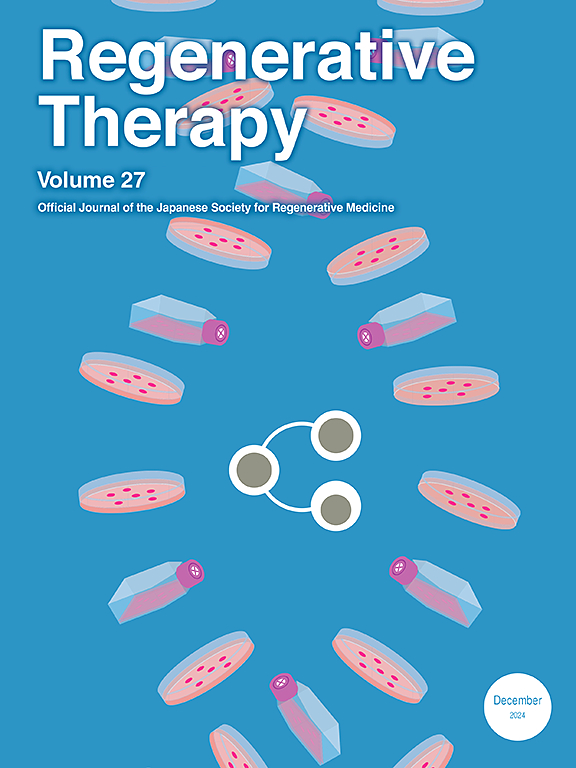在缺血性心肌病大鼠模型中,系统给予诱导多能干细胞衍生的间充质干细胞通过细胞外囊泡介导的组织修复改善心功能。
IF 3.4
3区 环境科学与生态学
Q3 CELL & TISSUE ENGINEERING
引用次数: 0
摘要
导论:系统给药诱导多能干细胞衍生间充质干细胞(iPS-MSCs)对心肌缺血有治疗作用。然而,基于ips - msc的系统性缺血性心肌病(ICM)治疗的治疗机制尚不清楚。我们通过细胞外囊泡(EV)介导的组织修复研究了iPS-MSCs在大鼠ICM模型中的治疗作用。方法:采用左冠状动脉前降支结扎法建立大鼠ICM模型。iPS-MSC组每周静脉注射iPS-MSC,持续四周,而对照组则给予生理盐水。将参与EVs生物发生的蛋白Alix敲除,并将敲除Alix的iPS-MSCs给予siAlix组。我们使用超声心动图、组织学分析、荧光染料细胞跟踪分析和治疗后心肌边界区综合RNA测序分析序贯心功能。结果:与对照组相比,iPS-MSC组左室射血分数(LVEF)明显改善。siAlix组LVEF明显低于iPS-MSC组。组织学分析显示,iPS-MSC组纤维化面积明显减少,微血管密度明显增加。细胞跟踪实验显示急性期心肌边界区有iPS-MSC积累。综合microRNA测序分析显示,来自iPS-MSCs的ev含有与抗纤维化和血管生成相关的mirna。对心肌组织中差异表达基因的基因本体论分析也显示,与抗纤维化和新生血管相关的通路上调,与炎症和t细胞分化相关的通路下调。结论:全身给药iPS-MSCs通过ev介导的血管生成和抗纤维化作用改善ICM心功能,提示治疗慢性心力衰竭的临床可能性。本文章由计算机程序翻译,如有差异,请以英文原文为准。

Systemic administration of induced pluripotent stem cell-derived mesenchymal stem cells improves cardiac function through extracellular vesicle-mediated tissue repair in a rat model of ischemic cardiomyopathy
Introduction
Systemic administration of induced pluripotent stem cell-derived mesenchymal stem cells (iPS-MSCs) has a therapeutic effect on myocardial ischemia. However, the therapeutic mechanism underlying systemic iPS-MSC-based therapy for ischemic cardiomyopathy (ICM) remains unclear. We investigated the therapeutic effects of iPS-MSCs through extracellular vesicle (EV)-mediated tissue repair in a rat model of ICM.
Methods
A rat ICM model was created by left anterior descending coronary artery ligation. iPS-MSCs were administered intravenously every week for four weeks in the iPS-MSC group, whereas saline was administered to the control group. Alix, a protein involved in the biogenesis of EVs, was knocked down, and Alix-knockdown iPS-MSCs were administered to the siAlix group. We analyzed sequential cardiac function using echocardiography, histological analysis, cell tracking analysis with fluorescent dyes, and comprehensive RNA sequencing of the border zone of the myocardium after treatment.
Results
Left ventricular ejection fraction (LVEF) was significantly improved in the iPS-MSC group compared with that in the control group. In the siAlix group, LVEF was significantly lower than that in the iPS-MSC group. Histological analysis showed a significant decrease in fibrosis area and significant increase in microvascular density in the iPS-MSC group. A cell-tracking assay revealed iPS-MSC accumulation in the border zone of the myocardium during the acute phase. Comprehensive microRNA sequencing analysis revealed that EVs from iPS-MSCs contained miRNAs associated with anti-fibrosis and angiogenesis. Gene ontology analysis of differentially expressed genes in myocardial tissue also showed upregulation of pathways related to antifibrosis and neovascularization and downregulation of pathways linked to inflammation and T-cell differentiation.
Conclusions
Systemic administration of iPS-MSCs improved cardiac function through EV-mediated angiogenetic and antifibrotic effects in an ICM, suggesting the clinical possibility of treating chronic heart failure.
求助全文
通过发布文献求助,成功后即可免费获取论文全文。
去求助
来源期刊

Regenerative Therapy
Engineering-Biomedical Engineering
CiteScore
6.00
自引率
2.30%
发文量
106
审稿时长
49 days
期刊介绍:
Regenerative Therapy is the official peer-reviewed online journal of the Japanese Society for Regenerative Medicine.
Regenerative Therapy is a multidisciplinary journal that publishes original articles and reviews of basic research, clinical translation, industrial development, and regulatory issues focusing on stem cell biology, tissue engineering, and regenerative medicine.
 求助内容:
求助内容: 应助结果提醒方式:
应助结果提醒方式:


